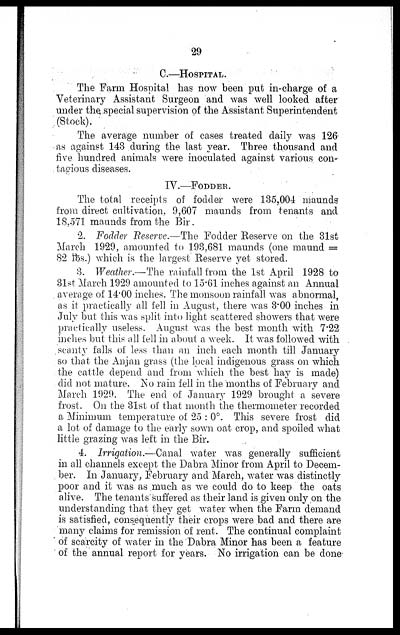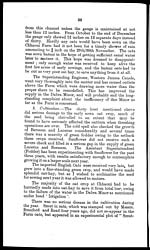Medicine - Veterinary > Civil Veterinary Departments > 1894-1932 - Annual report of the Punjab Veterinary College and of the Civil Veterinary Department, Punjab > 1926-1932 > 1928-1929 - Annual report of the Civil Veterinary Department, Punjab, for the year 1928-29
(416) Page 29
Download files
Individual page:
Thumbnail gallery: Grid view | List view

29
C.—HOSPITALS.
The Farm Hospital has now been put in-charge of a
Veterinary Assistant Surgeon and was well looked after
under the special supervision of the Assistant Superintendent
(Stock).
The average number of cases treated daily was 126
as against 143 during the last year. Three thousand and
five hundred animals were inoculated against various con-
tagious diseases.
IV.—FODDER.
The total receipts of fodder were 135,004 maunds
from direct cultivation, 9,607 maunds from tenants and
18,571 maunds from the Bir.
2. Fodder Reserve.—The Fodder Reserve on the 31st
March 1929, amounted to 193,681 maunds (one maund =
82 lbs.) which is the largest Reserve yet stored.
3. Weather.—The rainfall from the 1st April 1928 to
31st March 1929 amounted to 15.61 inches against an Annual
average of 14.00 inches. The monsoon rainfall was abnormal,
as it practically all fell in August, there was 3.00 inches in
July but this was split into light scattered showers that were
practically useless. August was the best month with 7.22
inches but this all fell in about a week. It was followed with
scanty falls of less than an inch each month till January
so that the Anjan grass (the local indigenous grass on which
the cattle depend and from which the best hay is made)
did not mature. No rain fell in the months of February and
March 1929. The end of January 1929 brought a severe
frost. On the 31st of that month the thermometer recorded
a Minimum temperature of 25 : 0°. This severe frost did
a lot of damage to the early sown oat crop, and spoiled what
little grazing was left in the Bir.
4. Irrigation.—Canal water was generally sufficient
in all channels except the Dabra Minor from April to Decem-
ber. In January, February and March, water was distinctly
poor and it was as much as we could do to keep the oats
alive. The tenants suffered as their land is given only on the
understanding that they get water when the Farm demand
is satisfied, consequently their crops were bad and there are
many claims for remission of rent. The continual complaint
of scarcity of water in the Dabra Minor has been a feature
of the annual report for years. No irrigation can be done
Set display mode to: Large image | Zoom image | Transcription
Images and transcriptions on this page, including medium image downloads, may be used under the Creative Commons Attribution 4.0 International Licence unless otherwise stated. ![]()
| Permanent URL | https://digital.nls.uk/75538333 |
|---|
| Additional NLS resources: |
|---|




